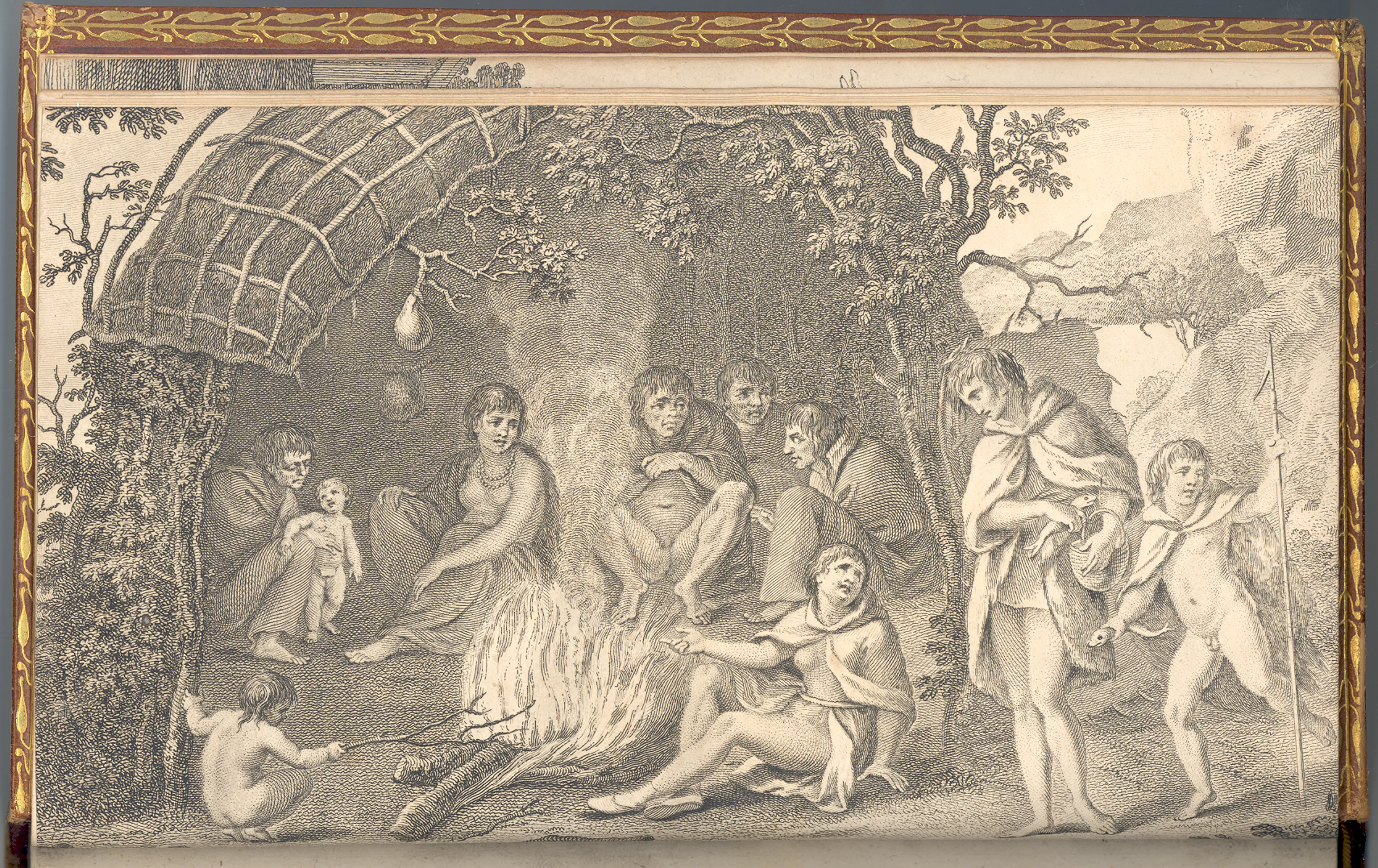Exhibit
Creation Date
1807
Height
12 cm
Width
20 cm
Medium
Genre
Description
Within a rocky landscape is situated a large, cave-like dwelling constructed of leaves and branches. Six adult figures and two small children sit or squat around a smoky fire, while two additional figures approach the encampment with freshly caught fish. Most of the figures have short-cropped hair and are partially covered by hooded cloaks.
There is a consistent tension in Romantic descriptions of gipsies between celebrating the freedom of nomadism and bemoaning the squalid conditions of homelessness. This print visualizes this tension by giving us images of both dignity and depravity and by simultaneously suggesting the idyllic and the condemnable conditions of a wandering existence.
Ethnographic images such as these strove to classify gypsies as an identifiable racial group, and to differentiate between particular types of gypsies (such as the rugged, Amazonian gypsy woman and the decrepit and elderly gypsy hag). Such images were included in both encyclopedic volumes of novel persons, which attempted to archive eccentric types, and more focused, scholarly treatises on the supposed cultural and biological differences of England’s domestic other.
The 1744 Vagrancy Act mandated that gypsies, beggars, strolling actors, peddlers and gamblers refusing to work for usual or common wages could be whipped or imprisoned by local magistrates (Mayall 258). In this way, any person refusing to participate in a wage-based system of labor was deemed criminal. The 1810 Licensing Act required the licensing of vagabonds, gypsies, hawkers and peddlers (Hawkes 13). This system of identification contributed to the surveillance of wandering persons and helped to enforce local ordinances specifying the maximum stay of non-residents in a town or its outskirts.
Throughout this period legal settlement remained a prerequisite for poor relief, meaning that the illegally settled, unsettled or wandering poor were routinely excluded from community or church-based assistance (Lloyd 117). Through the so-called “Speenhamland system,” parishes subsidized wages according to the parishioner’s need, determined by the cost of bread and number of dependents (Lloyd 115). In this way, most discussions of poverty revolved around the adequacy or inadequacy of earnings, and thus excluded those who did not participate in a wage-based economy. The process of consolidating and enclosing commons, wastelands and open fields into private holdings demarcated by fences, walls, hedgerows or trenches originated in the late medieval period, but experienced an unprecedented surge in England between 1793 and 1815 (McCalman 496). In many regions the process of enclosure eroded customary rights, including the right to graze animals, gather wood (estover), fish (piscary), cut peat (turbary), and glean wheat or produce left after the harvest (Janowitz 155). Like the agricultural laborers that depended on access to common lands to supplement their meager incomes, the members of nomadic or wandering classes attempting to live off the land were adversely affected by the loss of these customary rights.
The Romantic tension between an emphasis on the idyllic freedom of gypsies and the simultaneous homelessness accompanying such freedom is reflected in the antithetical tones of Wordsworth’s and Clare’s poetic descriptions (quoted above). The above print visualizes this tension by giving us images of both dignity and depravity. The young boy on the far right with elevated heel, raised leg, and prominent staff seems to mediate between the movement of the Apollo Belvedere and Giambologna’s statue of Mercury, while the figure directly to his left exhibits the gentle contrapposto, curved left arm, and bowed head of the Farnese Hermes. These figures, and to a lesser extent the female figure at the threshold of the hut, retain an elegance and stature denied those figures crouching within the rustic hovel. While the nudity of the young fisherman is made innocent by the subtle quotation of a classical ideal, the undignified squat of the print’s central figure is used to underscore the poverty and shame of homelessness. Exposed to view in such an inelegant position, the artist seems incapable of articulating the genitals of the crouching man, though they are clearly delineated on the fisherman figure. This image seems to celebrate the mobility and self-sufficiency of the gypsy while simultaneously suggesting that in their temporary stasis they become increasingly savage and unclean.
Collection
Accession Number
Thordarson T 1836
Additional Information
Bibliography
Clare, Jonathan. "The Gipsies' Evening Blaze." “I am”: The Selected Poetry of John Clare. Ed. Jonathan Bate. New York: Farrar, 2003. 25. Print.
Grellmann, Heinrich Moritz Gottlieb. Dissertation on the Gipseys. London: William Ballintine, 1807. Print.
Hawkes, Derek and Barbara Perez. The Gypsy and the State: The Ethnic Cleansing of British Society. Oxford: Alden P, 1995. Print.
Janowitz, Anne. “Land.” An Oxford Companion to the Romantic Age: British Culture 1776-1832. Ed. Iain McCalman, et al. Oxford: Oxford UP, 1999. 152-161. Print.
Mayall, David. Gypsy Identities 1500-2000: From Egipcyans and Moon-men to the Ethnic Romany. New York: Routledge, 2004. Print.
McCalman, Iain, et al. An Oxford Companion to the Romantic Age: British Culture 1776-1832. Oxford: Oxford UP, 1999. Print.
Wordsworth, William. "The Gipsies." Selected Poetry. Ed. Stephen Gill and Duncan Wu. Oxford: Oxford UP, 1997. 151. Print.

